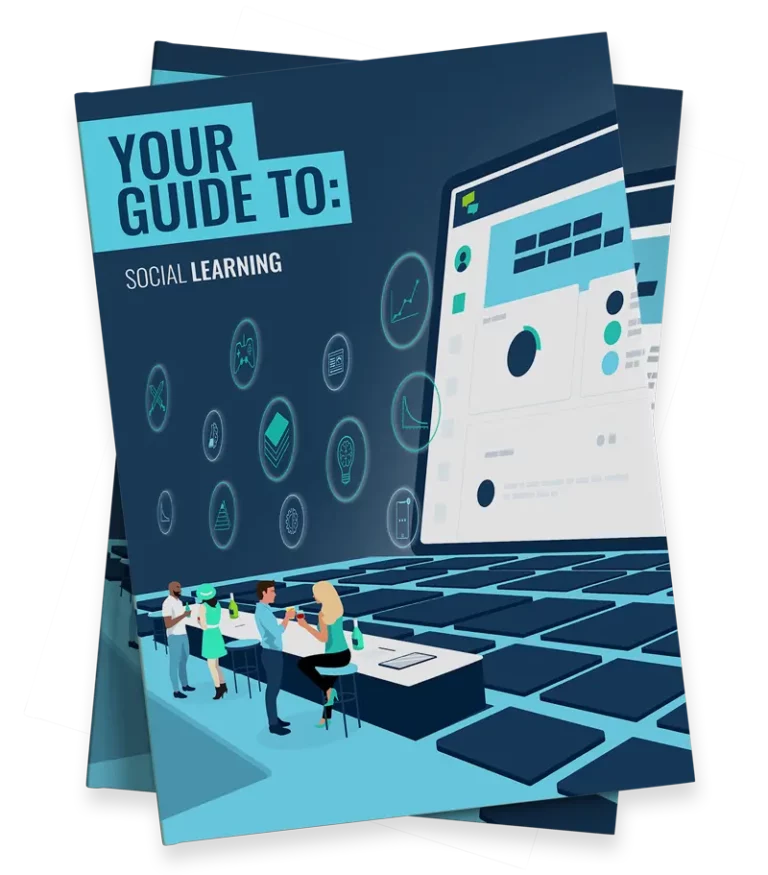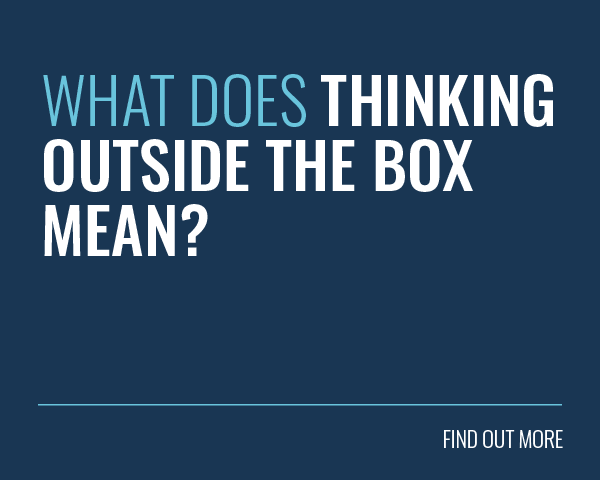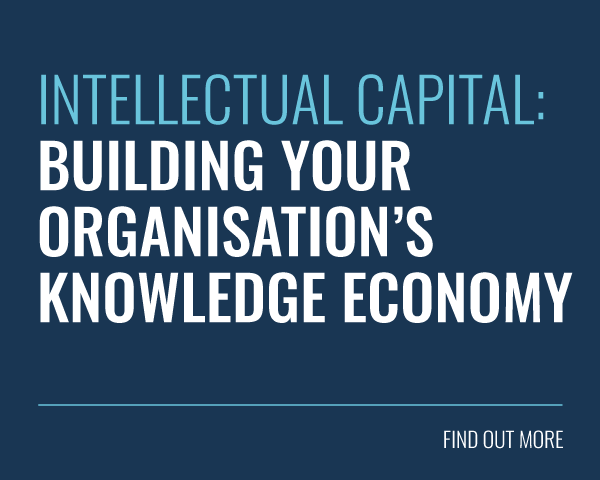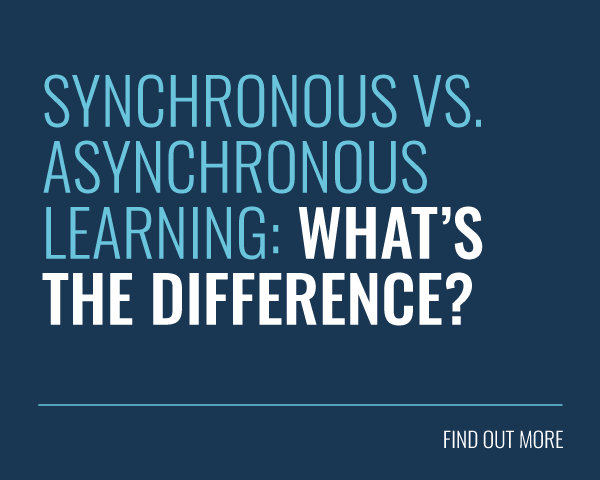
Learning professionals are used to being asked to do more with less. You’re often saddled with tighter budgets, unrealistic deadlines and a shortage of resources. But what if you had access to a legion of passionate content creators?
This is the role that user-generated content can play in your training toolkit.
User-generated content is the lifeblood of platforms like Instagram, Facebook, TikTok and Reddit. It’s the reason why Wikipedia has been so successful. It’s time for corporate learning and development to sit up and take notice.
By harnessing your team’s knowledge you can reduce your costs, increase the reach of your training programme and fuel better results. You’ll also create more authentic learning experiences that empower and engage your learners. What’s not to love?
As Malcolm Gladwell notes in The Tipping Point, ‘when people are overloaded with information… they turn to people they respect, admire and trust’. As we’ll soon see, these trusted voices aren’t brands or organisational leaders. They’re our peers and co-workers.
In this article, we’ll explore the role of user-generated content in learning, share some examples and explore the benefits and challenges. Ready? Then let’s unleash your learners’ potential!
What is User-Generated Content (UGC)?
If you’ve ever shared a snap of your new outfit on Instagram, interacted with a business on LinkedIn or reviewed a product on YouTube, then you’ve (wittingly or unwittingly) produced user-generated content (UGC).
User-generated content is original and brand-specific content that is not created by the brand itself. It’s created by individuals and consumers and published through social media or other channels.
In other words, it’s the users who are in control. They generate the content without any corporate governance or oversight. How freeing!
User-generated content comes in a variety of shapes and sizes. This can include social posts, images, videos, reviews or even a reference in a podcast. It can also come from a variety of sources, including your customers, advocates and employees.
As it happens, it can also originate from your learners. That brings us neatly onto our next topic.
What is Learner-Generated Content?
Learner-generated content is user-generated content that has been created for use in your training initiatives. This content is created voluntarily by the learner and is not commissioned, edited or directed in any way.
Traditionally, the majority of your training content is produced by subject matter experts, training managers and instructional designers. But there’s no reason why that has to be the case. Learner-generated content flips this expectation on its head.
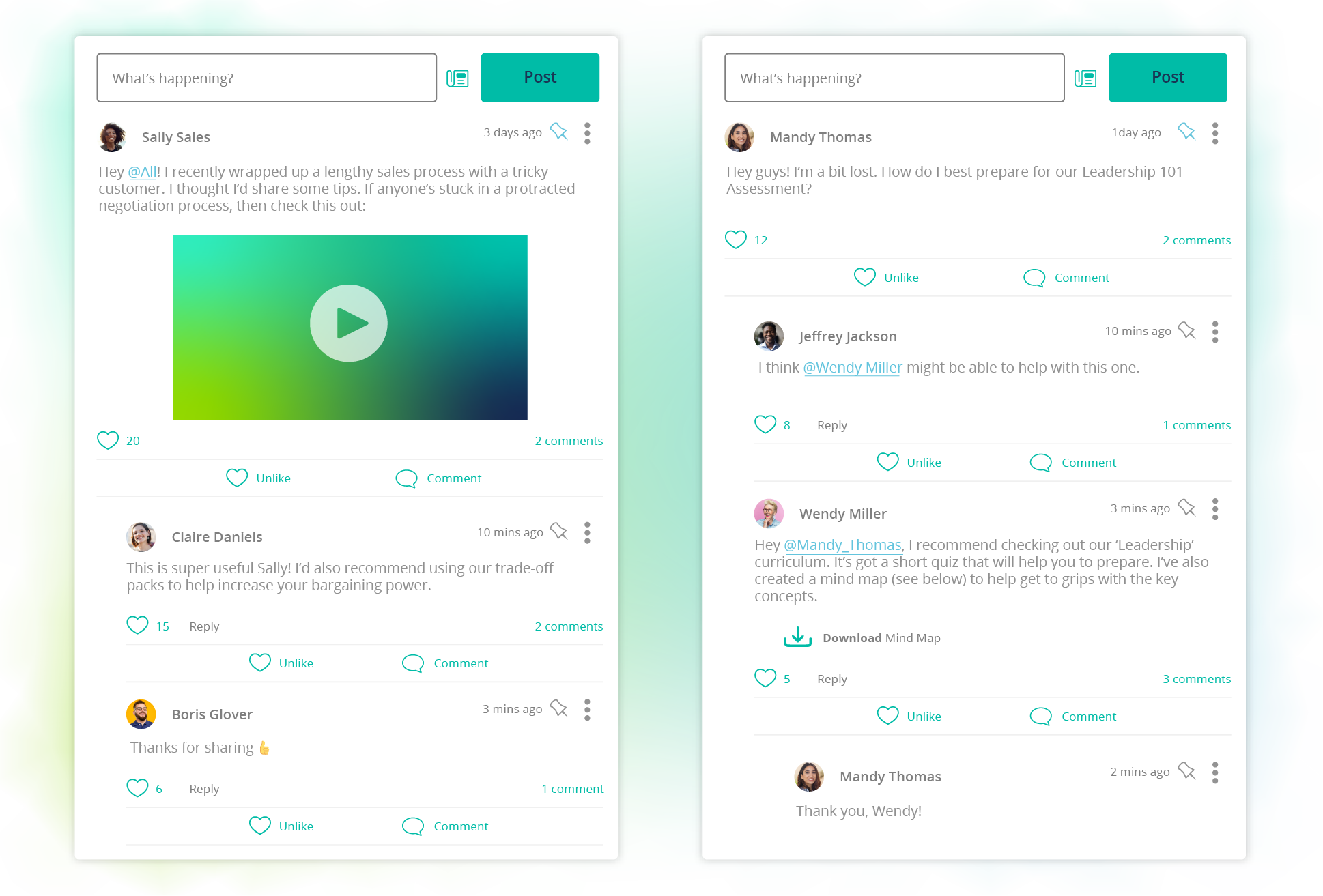
You have a treasure trove of knowledge hidden within your learner community. All you need to do is unlock it. As is often the case with social learning, letting go of control might just set you free.
Remember, the goal isn’t to replace your formal training programme with user-generated content. This content will supplement your existing assets helping to extend your reach, control your budget and improve your impact.
That said, if your user-generated content is good enough, you may well want to add it to your formal training curriculum.
The Power of Authenticity
90% of consumers say they’ll only support ‘authentic’ brands.
Well, what’s more authentic than user-generated content? It’s based on meaningful experiences, genuine opinions and real voices. It’s also unfiltered and unvarnished — it gives it to us ‘as it is’. This, in turn, encourages us to sit up and listen.
As this happens, oxytocin is released in our brain. This neurotransmitter plays an important role in many human behaviours, including building trust.
Our level of trust varies depending on our relationship with the individual in question. According to the Edelman Trust Barometer, we trust our coworkers above journalists, our neighbours and even our boss. In fact, the only people we trust more are scientists.
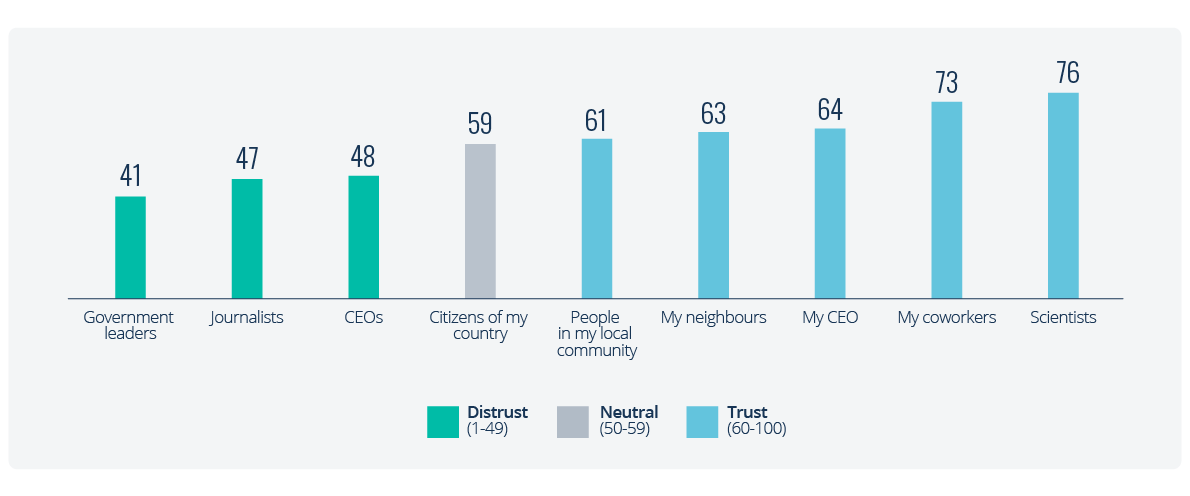
At the same time, we have started to place less trust in institutions and government leaders. What’s more, according to the Gustavson Brand Trust study, our faith in brands is declining. User-generated content gives us something to believe in again.
User-generated content also has a unique ability to showcase authentic emotions. This can take various forms. For example, the sheer joy of mastering a new skill, the frustration of a new challenge or the confusion that arises from a policy change.
This combination of authenticity and emotion is a potent force.
What Are The Benefits of User-Generated Content?
Authentic user-generated content clearly has a role to play in the learning arena. But what advantages does it offer both instructors and learners? Let’s explore:
- Active Engagement: User-generated content transforms learners into active participants in the learning process. After all, there’s no way to passively share your thoughts on a topic. By becoming a content creator, you’re reaching the top level of Bloom’s Taxonomy and earning a deeper understanding of the topic at hand.
- Diverse Voices: You can’t fully grasp a topic unless you’ve examined it from every angle. User-generated content introduces diverse viewpoints and perspectives into your learning environment. Indeed, learners from different backgrounds are likely to have unique insights that enrich the overall learning experience.
- Continuous Learning: Learning doesn’t have to stop when your formal training programme comes to an end. User-generated content encourages ongoing learning and knowledge sharing. This helps you to remove any artificial boundaries from around your training initiative. You might just end up with a learning culture.
- Reinforcement Opportunities: Have you ever heard the phrase, ‘if you want to master something, teach it’? This phenomenon is known as the protégé effect. Teaching leads to improved motivation and increased metacognitive processing. User-generated content makes teachers of us all and provides more opportunities for knowledge reinforcement.
- Cost-Effective: Creating new training content is costly and time-consuming. Whilst L&D budgets are slowly increasing, learning professionals still need to allocate resources wisely. Fortunately, they can always rely on user-generated content to supplement their existing materials. After all, there’s no costs associated with this content.
- Internal Marketing: When an employee shares their insights they’re also acting as an advocate within your training programme. Indeed, good user-generated content provides a goldmine of internal marketing opportunities. When it’s time to get the word out about your initiative, ensure you use the most authentic voices possible.
User-Generated Content: The Research
User-generated content first originated in marketing circles before it was applied to a learning context. As a result, there’s a good deal of research on the topic. We’ve summarised our findings below.
- Consumers are 2.4x more likely to say that user-generated content is more authentic than branded content.
- User-generated content is 35% more memorable than other content types.
- 79% of consumers agree that user-generated content impacts purchase decisions.
- Ads that utilise user-generated content earn 4x higher click-through rates.
- 80% of organisations are already leveraging user-generated content as part of their L&D strategy.
Clearly, if you’re not taking advantage of user-generated content then you’re missing out.
How to Encourage User-Generated Content?
Ready to introduce user-generated content into your learning mix? This will require creating a culture that empowers your learners to contribute their insights and experiences. Here are some strategies to help foster this engagement.
1. Set Expectations: Sometimes you just need to get the ball rolling. You should let your learners know that their contributions are valued and encouraged. Consider providing a set of guidelines (see below) or sharing best practice advice. You could even lead by example and share your own insights where relevant.
2. Provide a Platform: User-generated content can’t exist in a vacuum. Your learners will need somewhere to go to share their expertise. We recommend utilising learning technology (such as a learning management system or learning app) so these informal learning activities can be monitored and tracked.
3. Request Feedback: Your learners need feedback in order to succeed. But feedback is a two-way street. Their feedback can help you to fine-tune your learning programme. It’s also a type of user-generated content. With this in mind, why not ask your learners to share constructive feedback and suggestions?
4. Incentivise Activity: Creating your own content can be time-consuming. Sharing your insights can feel intimidating. As such, your learners might need a bit of encouragement. Consider using real world rewards or gamification features such as XP, Badges and Leaderboards to drive activity. Let’s get engaged!
5. Make it Fun: Seek to create a space that is user-friendly, accessible and fun. This will naturally encourage participation. For instance, you can use polls, quizzes, challenges, battles, team events, scavenger hunts and so on. Why not challenge your learners to caption a photo or host a meme creation contest?
6. Leverage Your SMEs: When your learners do engage, don’t leave them hanging. ‘Like’ their posts, add a response and share your own thoughts. You should also encourage experts from throughout your organisation to join the conversation. They’ll be able to do some fact checking and add value to the learning experience.
The Challenges of User-Generated Content
Unfortunately, user-generated content does not come without limitations. It’s important that you’re aware of these challenges before you start to encourage UGC within your learning environment.
- Quality Control: Your learners aren’t instructional designers. They don’t know the very best learning methodologies or the latest learning theories. As a result, much of the content created by your learners will fail to meet educational standards. It may also be undermined by spelling and grammar issues or formatting errors.
- Misinformation: Worse still, user-generated content can sometimes just be plain wrong. Inaccuracies or misinformation can actively damage your organisation. As such, we would recommend keeping a close eye on your learning community. You should also encourage your learners to critically evaluate any information they encounter.
- Participation: Most of your learners are busy. Estimates suggest that they have time for about 1.2 hours of learning per week. They won’t all be clamouring to share their knowledge. Drumming up motivation will take some work. However, it’s worth remembering that this is time you’d otherwise be spending creating formal training.
- Focus: As a learning professional, you have objectives that you need to meet. You’re responsible for promoting growth throughout your organisation. Unfortunately, your learners won’t always share this focus. This divergence in attention can be disruptive and distracting.
Many of these issues will already exist within your organisation, regardless of whether you encourage user-generated content. After all, your learning and development function has no oversight over the majority of learning that takes place on the job.
For instance, there’s no way to track information (or misinformation!) that gets shared over Slack, on MS Teams, on Zoom calls or at the coalface of work itself.
Whilst you can’t control everything, adopting a digital learning platform and encouraging UGC will improve your visibility. This gives you the opportunity to act as a quality control agent and step in when necessary.
Guidelines for User-Generated Content

There you have it: the good, the bad and the ugly when it comes to user-generated content. Despite these challenges, we’re still huge UGC advocates. After all, there are very few other ways to create cost effective, authentic and engaging learning experiences.
With this in mind, we’d recommend setting guidelines within your learning environment. These standards can help you to resolve some of the challenges listed above. Here’s a few suggestions to get you started.
- Show Respect: Be respectful and inclusive in your interactions and content.
- Strive for Quality: Prioritise accuracy and reliability in your content.
- Show Your Sources: Back your claims up with evidence where necessary.
- Respect Copyright: Uphold and honour intellectual property rights.
- Remain Relevant: Ensure your content aligns with the goals of the community.
- Actively Engage: Participate in discussions and engage with others.
- Stay Curious: Question everything and don’t be afraid to fact check information.
- Be Vigilant: Avoid sharing personal information and be aware of cybersecurity risks.
Where necessary, you should also consider creating and sharing templates that your learners can use. This will ensure consistency of format and structure and will provide useful guidance to your learners.
Examples of Successful UGC Campaigns in Learning
There are countless examples of successful user-generated content campaigns from the world of marketing and advertising. Take, for instance, Coca-Cola’s ‘Share a Coke’ campaign, Apple’s ‘Shot on iPhone’ campaign or Calvin Klein’s ‘My Calvins’ campaign.
But what of the learning and development landscape? To help inspire you, we’ve included two great examples of learning programmes that successfully deployed user-generated content.
Together Co.
Together Co. are a leading loneliness charity based in the UK. They worked with Storytagger to provide a learning solution for their volunteers.

This solution was particularly important during the pandemic, when loneliness and uncertainty was rife. It helped to onboard new team members and facilitate user-generated content. This content led to real impact:
- The number of volunteers increased by 300%.
- Training time was reduced by 50%.
- Volunteers were able to provide an additional 1,000 hours of support.
L’Oréal Travel Retail
L’Oréal is the world’s leading cosmetics provider. This project focuses on 3,600+ Beauty Advisors working in travel retail locations in the Americas and APAC. This audience accesses continuous learning opportunities through Growth Engineering Learning App.

Features like social streams, discussion forums and game mechanics help to encourage user-generated content. The engagement levels have been spectacular.
- Over 12 million examples of user-generated content have been shared via the app.
- That’s over 18,000 social engagements every day.
- It’s estimated that this has reduced travel and training related costs by 30%.
Each year, L’Oréal Travel Retail hosts a glamorous awards event to celebrate the most engaged users and the best learner-generated content.
As Valerie Benites, eLearning Project Manager at L’Oréal Americas noted, ‘This is an innovative tool with social and gamification features that help to foster a real learning community. It gives our teams a sense of place and promotes peer-to-peer learning.’
Final Word
We’ve never demanded more from our learning professionals. They’re expected to keep up with a torrent of new legislations, guidelines, policies and training needs — all without the budget and support they need to be successful.
It’s little wonder that enterprising learning and development teams have started to explore new approaches. This is yet another opportunity for learning professionals to borrow from the marketing playbook. User-generated content could be your secret weapon.
After all, user-generated content is a cost-effective means of expanding the shelf-life of your training campaigns. It’s also authentic. Genuine reactions and real emotions always trump one-way corporate communications.
So, how will you encourage user-generated content in your learning environment?
Thank you for reading. Want to learn more? Then download ‘Your Sensational Social Learning Guidebook’ and supercharge your informal learning strategy!

